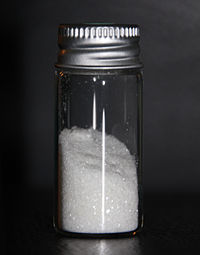Ethylenediaminetetraacetic acid
 |
|
 Disodium EDTA
|
|
| Names | |
|---|---|
|
Systematic IUPAC name
2,2',2'',2'''-(Ethane-1,2-diyldinitrilo)tetraacetic acid
|
|
Other names
|
|
| Identifiers | |
|
3D model (Jmol)
|
|
| Abbreviations | EDTA, H4EDTA |
| 1716295 | |
| ChEBI | |
| ChemSpider | |
| DrugBank | |
| ECHA InfoCard | 100.000.409 |
| EC Number | 200-449-4 |
| 144943 | |
| KEGG | |
| MeSH | Edetic+Acid |
|
PubChem CID
|
|
| RTECS number | AH4025000 |
| UNII | |
| UN number | 3077 |
|
|
|
|
| Properties | |
| C10H16N2O8 | |
| Molar mass | 292.24 g·mol−1 |
| Appearance | Colourless crystals |
| Density | 860 mg mL−1 (at 20 °C) |
| log P | −0.836 |
| Acidity (pKa) | 1.782 |
| Basicity (pKb) | 12.215 |
| Thermochemistry | |
|
Std enthalpy of
formation (ΔfH |
−1.7654 to −1.7580 MJ mol−1 |
|
Std enthalpy of
combustion (ΔcH |
−4.4617 to −4.4545 MJ mol−1 |
| Pharmacology | |
| S01XA05 (WHO) V03AB03 (WHO) (salt) | |
|
|
| Hazards | |
| GHS pictograms |  |
| GHS signal word | WARNING |
| H319 | |
| P305+351+338 | |
|
EU classification (DSD)
|
|
| R-phrases | R36 |
| S-phrases | (S2), S26 |
| NFPA 704 | |
| Lethal dose or concentration (LD, LC): | |
|
LD50 (median dose)
|
1000 mg/kg (oral, rat) |
| Related compounds | |
|
Related alkanoic acids
|
|
|
Related compounds
|
|
|
Except where otherwise noted, data are given for materials in their standard state (at 25 °C [77 °F], 100 kPa).
|
|
|
|
|
| Infobox references | |
Ethylenediaminetetraacetic acid (EDTA), also known by several other names, is a chemical used for both industrial and medical purposes.
It is an aminopolycarboxylic acid and a colourless, water-soluble solid. Its conjugate base is ethylenediaminetetraacetate. It is widely used to dissolve limescale. Its usefulness arises because of its role as a hexadentate ("six-toothed") ligand and chelating agent, i.e., its ability to "sequester" metal ions such as Ca2+ and Fe3+. After being bound by EDTA into a metal complex, metal ions remain in solution but exhibit diminished reactivity. EDTA is produced as several salts, notably disodium EDTA and calcium disodium EDTA.
In industry, EDTA is mainly used to sequester metal ions in aqueous solution. In the textile industry, it prevents metal ion impurities from modifying colors of dyed products. In the pulp and paper industry, EDTA inhibits the ability of metal ions, especially Mn2+, from catalyzing the disproportionation of hydrogen peroxide, which is used in "chlorine-free bleaching". In a similar manner, EDTA is added to some food as a preservative or stabilizer to prevent catalytic oxidative decoloration, which is catalyzed by metal ions. In soft drinks containing ascorbic acid and sodium benzoate, EDTA mitigates formation of benzene (a carcinogen).
The reduction of water hardness in laundry applications and the dissolution of scale in boilers both rely on EDTA and related complexants to bind Ca2+, Mg2+, as well as other metal ions. Once bound to EDTA, these metal centers tend not to form precipitates or to interfere with the action of the soaps and detergents. For similar reasons, cleaning solutions often contain EDTA.
...
Wikipedia

